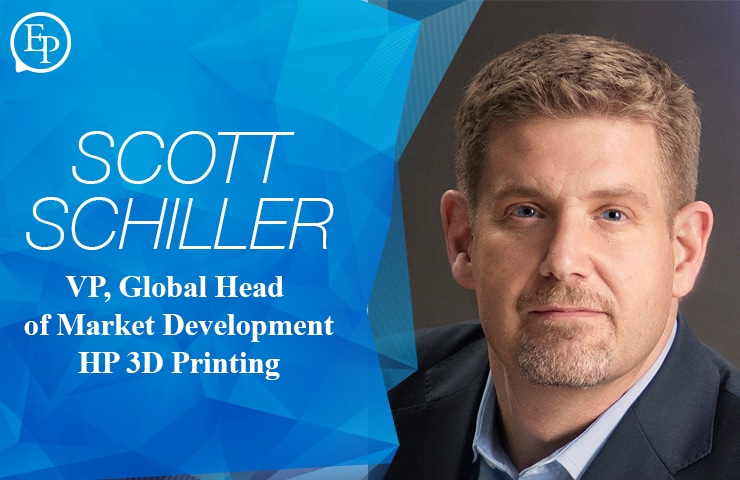
As part of the 2019 edition of the North American Manufacturing Excellence Summit, Scott Schiller, HP 3D Printing’s VP, Global Head of Customer and Market Development, gave an in-depth interview on how Industry 4.0 solutions are changing the very nature of Integrated Business Planning.
The full transcript of the interview is below, or you can download a PDF version.
Tell us a little about how HP is using 3D printing technology to change its supply chain.
At HP, we believe digital manufacturing can completely revolutionize major industries from auto to healthcare to heavy industry, and that core digital technologies like 3D printing enable the innovation to do so. HP itself is one of the world’s largest manufacturers, doing business in 170 countries and shipping more than 100 million products per year through its supply chain.
HP is digitally reinventing itself by leveraging its own Multi Jet Fusion 3D printing technology in designing and manufacturing HP products across all business units. Most recently, our own Print and 3D Printing businesses have discovered previously impossible efficiencies and advantages and are accelerating the adoption of digital manufacturing across the entire product lifecycle.
What motivated HP to move forward with this strategy?
HP began its digital manufacturing journey with the 3D printing business unit. The team was presented with an exercise to determine how many parts in the Jet Fusion 300/500 Series 3D printers could be printed with MJF. Historically, you would likely find a handful of parts that make sense to be 3D printed. But in partnership with our design team, we found around 25 parts that made sense from a design perspective to 3D print for the Jet Fusion 300/500 Series.
From there, the team began working with procurement and manufacturing engineering, and it opened the possibilities further. The number of parts justified to 3D print went from 25 to over 140, making the Jet Fusion 300/500 Series “the printer that print’s itself.” Because we’ve been able to minimize tooling and assembly, we’ve created a 30 percent cost saving and cut development time in half.
This success story motivates us to move forward because our mentality is that if there is one success, there are bound to be more – not only within HP but for our customers. We’re able to take key learnings and considerations from our successes to guide customers in their journey to digitally transform their supply chains. For example, we have learned that we must determine early enough in the product lifestyle to understand how to apply 3D printing and we’re helping customers to identify those crucial moments. And when we can connect all the dots, it unlocks greater potential and has a cascading impact.
Walk us through the rollout. How did things scale up from the pilot project to the present day’s capabilities? And let’s talk results. What is HP capable of doing today that it could not do before Multi Jet Fusion was successfully incorporated into the organization?
After the success we experienced with the Jet Fusion 300/500 Series, we committed to becoming best in class for building a supply base for Multi Jet Fusion. With that in mind, we tasked ourselves with determining how to scale across our business in addition to scaling awareness, best practices and quality control. To do that, we’ve begun implementing Multi Jet Fusion into the supply chain across the rest of our business.
Designing with the capabilities of HP Multi Jet Fusion 3D printing technology in mind, HP’s digital printing group, Indigo Printing, has redesigned more than 21 parts for the Indigo 12000 Digital Press printer leading to 80 percent cost reduction and 91 percent assembly reduction. In fact, to date, 30 percent of Indigo engineers have undergone Design for Additive Manufacturing training.
By implementing Multi Jet Fusion in our thermal inkjet printheads supply chain, we were able to redesign consolidate seven parts into one at a 95 percent cost reduction and 90 percent weight reduction. We’ve also been enabled to create large format spare parts on demand, reducing excess inventory and emissions from transportation.
In the HP Latex Printing group, HP’s design engineers used generative design to optimize a part required to hold a sensor in place within a large format printer. It was traditionally made in aluminum, and by printing the redesigned part with Multi Jet Fusion, the weight of the part was reduced by 93 percent, the carbon footprint reduced by 95 percent, and cost was cut in half.
How do you see those capabilities continuing to evolve moving forward? Where do you expect the industry to be five or ten years down the road with 3D printing and additive manufacturing?
The nature of conversation about 3D printing has shifted from early stage exploration to exploring broad mainstream applications. Adoption is happening far more broadly across the product lifestyle across industries including auto, healthcare and heavy industry rather than in specific ways like prototyping, and companies are beginning to experience economic advantages.
The key to driving economic advantages for 3D printed parts is to continue improving the technological and economic inflection points based on the speed, quality and scalability needed by the manufacturer or business.
The breakeven point is key in determining if it is more advantageous to create the part via traditional manufacturing or additive manufacturing. This is the point in production when additive manufacturing is a more cost effective than injection molding. It is also important to consider the high initial costs for injection molding, part size and part complexity factors.
The HP Jet Fusion 4200 printing solution provided a breakeven point of 50,000 units. We also offer the HP Jet Fusion 4210 system which offers lower operating costs and increase volume production capabilities, raising the breakeven point for large-scale manufacturing to 110,000 parts.
This is a great start, but our ambition is to, in time, get to rates of a million plus. Not in the next month, not next year, but to ultimately help accelerate the industry to this position.
Whenever I hear about a new technology changing the way supply chains function, I think how that has impacted the people within the organization. Can you talk about the people part of this transformation?
Widespread use of 3D printing creates a demand for new design skillsets and in many cases, adjusting our thinking surrounding what constraints have previously been established. As innovation continues to take hold and change the economic landscape of the manufacturing industry, there will be new, previously unpracticed technical and automation skills required within engineering, computer programming and data science.
But first, more than skills, it requires a change of mindset. It is critical for us to think about designing for 3D printing from the first stages of a product development and embrace the limitless design possibilities the technology enables. For years we’ve been limited to what traditional manufacturing methodologies were able to do for us, and now we must open our minds.
HP is developing a series of materials and workshops, to help companies adopt the design for additive manufacturing mindset.
We’ve experienced it ourselves and now we’re launching tools, such as handbooks, based on our own learnings during the 3D adoption journey in our own company.
What are some of the key takeaways other manufacturing and supply chain executives should think about based on HP’s experience with this technology?
Businesses and their leaders need to start thinking about the benefits of additive manufacturing now. As we’re experiencing greater adoption across the board, we’re championing the value creation 3D printing provides. We are now able to make parts that were previously inconceivable with potentially more distributed production. 3D printing has profound implications for design flexibility and how we can interact and influence the design from the beginning to create greater outcomes at lower price points and more efficiently.
One way to take action today is to provide effective training opportunities, enabling engineers to more easily understand and identify the advantages of designing for additive manufacturing.
—

















